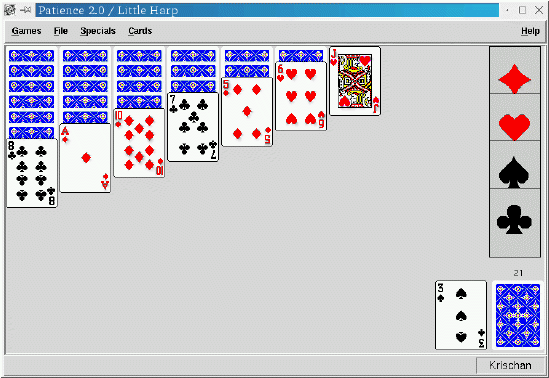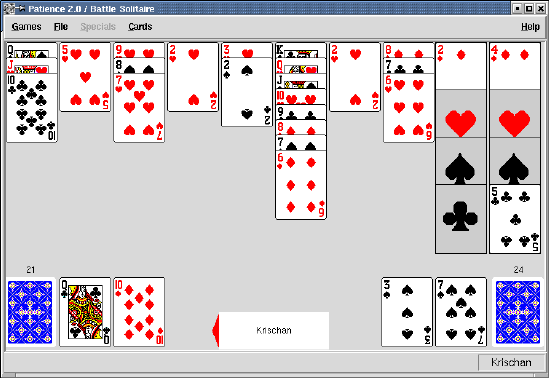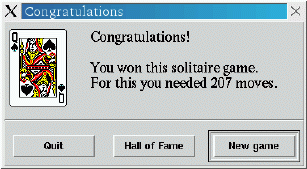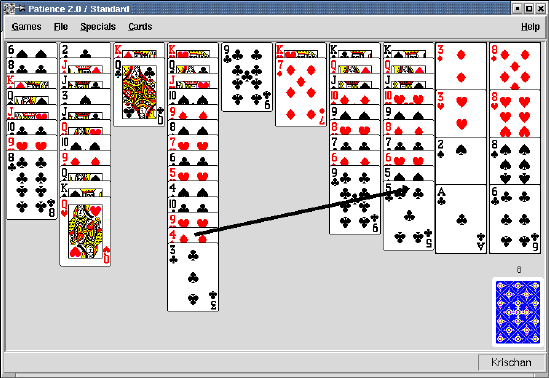
All games of Patience, regardless of the other rules, are played with bridge cards. A deck consists of 52 cards: the numbered cards from 2 to 10, the Jack, Queen, King and Ace, each in the suits Diamonds, Hearts, Spades and Clubs. Depending on the set of rules used, the game is played with one or two decks, i.e. there are either 52 or 104 cards in play.
To begin with, all the cards to be used in the game are shuffled ,,in the player's hand'' (at the bottom-right corner of the screen).
From the well-shuffled hand one or more cards are added to the piles. The piles are in a row from left to right at the top of the playing field. Depending on the set of rules used, there can be different numbers of piles: Canfield, for example, only has four, while Spider has the maximum number of ten.
The top card on each pile is turned up, i.e., its value and suit are visible. Any cards underneath are normaly hidden, i.e., only the back of the card is visible. Only in Seahaven all cards on all piles are visible right from the start.
The number of hidden cards in a pile again depends on the set of rules. Little Harp, for example, earns its name from the fact that from left to right there is an decreasing number of hidden cards in the piles.
There is a reserve pile in some of the games. This is a pile of cards beside the hand with only the top card visible.
At the deal, after the piles have been set up, a fixed number of cards is transferred from the hand to the reserve pile - in Little Harp, for example, three cards. If there is no reserve pile, one card per pile is dealt from the hand.
If the hand is empty, but the reserve pile contains some cards, these cards can be moved back to the hand by clicking on the empty hand. There are rules, in which a limit of these turns exist.
There can also be a so-called penalty pile - or lazy pile - in a solitaire game. It is shown in the bottom-left corner and consists of a fixed number of cards which are taken from the hand before the piles will be set up. As with the reserve pile, only the top card's value is visible.
The stacks can be seen at the right-hand side of the screen. The object of the game is to place all the cards on the stacks. The bases of the empty stacks show that each stack is reserved for one suit only, e.g. the topmost for Diamonds. Depending on the number of cards in the game there are four or eight stacks, i.e. one for each suit in each full deck of cards.
Sometimes there can be so called work piles on the left side of the stacks, on which any card can be laid; but just one card per pile.
After dealing the playing field may show a little harp shape (for which one deck of cards is used) consisting of seven piles, each with a different numbers of cards, and a reserve pile, but no penalty or work piles, as depicted in picture Little Harp.

A little harp directly after the deal
Not all of what was said in the sections above is true for a battle solitaire.
The player and the partner (regardless if computer or some other player) get their own hand, the one of the partner at the bottom of the right side, the player's one on the left. On each hand the cards are shuffeled seperate, so that at the beginning of a game each card is once in each hand.
The reserve pile and the penalty pile are double each, too. Likewise the piles of the partner are to the right, the piles of the player to the left.
During a game there is always one participant's turn, i.e. only the player or the partner may move cards. In the middle of the bottom of the playing field there is a big button, which displays the name of the participant whose turn it is. There is a red arrow tip attached to the button pointing to the private piles of the active player.
The labeled button works like a chess clock; if the player can't move cards any more, she presses the button to signal the computer's or partner's turn. The sign on the button will change (the name of the partner or the word Computer will be shown) and the partner plays as long as possible, before the name of the player will appear again.
After playing a while against the computer, the playing field may look like in picture Battle solitaire.

Battle solitaire
At the start of a battle solitaire it will be determined, who's turn it is, i.e. who's name is displayed in the button (and hence has the right to move cards). This happens by card picking; from both shuffeled hands a card will be pulled. The comparison of the cards determines the beginner; its the player with the higher value. For same values the rule goes: Clubs about Spades about Hearts about Diamonds.
Using the mouse, the player can move the pointer to a card of her choice. If she presses the left mouse button the card follows the cursor for as long as the button is depressed. Visually speaking, the player has now picked up the card, carried it around the playing field and then dropped it.
If there is a card on a pile with its back facing up, it can be turned over by clicking on it with the left mouse button.
If the new position of the card is not a stack or pile (inclusive the reserve pile, penalty pile or work piles), the card is automatically returned to its starting position. If the new position is one of the above but is not in accordance with the rules described in the following, the card is likewise returned to its starting position.
In a battle solitaire no card may be picked up from the piles of the partner (hand, reserve pile and penalty pile) in the bottom-right corner of the screen.
If all appears to be correct, the card is brought to rest neatly in its new position. The computer keeps an internal account of all correct moves, which means it knows how many moves were required to solve the game and can report this in the congratulatory message (see picture Congratulations) or put it into the highscore list (see reference Commands/Hall of Fame...). However, as a result the player can also undo every move, if she so desires - the necessary commands are provided in reference Commands/Undo.

Congratulations on solving a game
If several cards are turned up on one pile and are in sequence, they can be moved in one go. To do this, click with the mouse on the bottom card of the sequence to be moved and carry it to its new position. If the bottom card matches the top card on the target pile, the entire sequence is moved to this new pile.
In picture Hint, for example, by clicking on the Six of Diamonds on the fourth pile from the left the sequence from Six to Four could be moved to the next right pile.
Sequences can only be moved to normal piles, and not to the reserve pile, the stacks, the work piles or the penalty pile. Note: For the stacks this is not true in Spider, as you will read in the next section.
The last few paragraphs have referred only to sequences in piles; however, an entire pile can also be moved if the sequence runs from the top to the bottom card.
The next highest card of the same suit can be moved to a stack on which there is already at least one card; e.g., the Ten of Spades follows the Jack of Spades. On an empty stack only a card with the lowest value can be moved - most of the time an ace. In Canfield the lowest card is determined by moving the top most card of the hand to the stack automatically; it's value is the lowest value in this game. Since now the King may not be the highest value any more, the Ace fits on a King (likewise cyclic).
In Spider there's a rule, that a family can only be brought complete to the stack. For this, the family first must be brought together on a pile before they can moved to the stack with one move. Here the game is solved already, when all families are completed on the piles; there is no need to move them to the stacks (see picture Spider). Since this situation is harder to achieve as placing all families on the stacks, in spider this is the highest goal to reach.

The highest goal in Spider
For the piles the general rule is as follow: Only the next smaller value fits on a card already there, and it exists the restriction: ,,Red on black, black on red,'' which is called alternating from now on. For example on a Nine of Clubs can be layed the Eight of Diamonds or the Eight of Hearts. On an empty pile every card fits.
No rule without it's exception:
In Little Harp only the highest card (a King) can be moved to an empty pile.
In Spider every card fits on another card with the next higher value; a moveable sequence however exists only of cards from the same suit. If e.g. a pile consists of a Nine of Clubs and Eight, Seven and Six of Hearts, only the top most three cards can be moved in one go. A Five of Clubs fits on this pile, however, the cards can't be moved together anymore.
In Seahaven a card fits only on a pile, if the pile is empty or the card is the next lower value of the same suit as the top most card of the pile.
In a standard solitaire, which is played a while and now the function Hint (see reference Commands/Hints) is called, the screen could look like in picture Hint.

A hint from the computer
There are six different kind of solitaire games shipped: the so called standard solitaire, Canfield, the Little Harp, Spider, Seahaven and a Battle solitaire. A description of the differences of the rules follows.
There are two decks of cards, i.e. 104 cards. It exists neither a reserve nor a penalty or work pile, but eight piles, containing three cards each at the start of a new game. On an empty stack there fits an Ace, on an empty pile every card. On an engaged pile a card fits, if it is the next lower value with alternating suit; together they form a moveable sequence.
There is one deck of cards, i.e. 52 cards. It exists no penalty or work pile, but a reserve pile, which will be filled with three card each deal, and seven piles containing between seven and one cards at the start of a new game. On an empty stack there fits an Ace, on an empty pile only a King. On an engaged pile a card fits, if it is the next lower value with alternating suit; together they form a moveable sequence.
There is one deck of cards, i.e. 52 cards. It exists a penalty pile with thirteen cards, a reserve pile, which will be filled with three card each deal, four piles containing one card each at the start of a new game, but no work piles. On an empty stack there fits only a card with the lowest value (the first on the hand), on an empty pile every card. On an engaged pile a card fits, if it is the next lower value with alternating suit; together they form a moveable sequence.
There are two decks of cards, i.e. 104 cards. It exists neither a reserve nor a penalty or work pile, but ten piles, containing five of six cards each at the start of a new game. Only complete families can be moved to the stack, on an empty pile fits every card. On an engaged pile a card fits, if it is the next lower value. They form a moveable sequence, if they got the same suit.
There is one deck of cards, i.e. 52 cards. It exists neither a reserve nor a penalty pile, but four work piles. At the start of a game every of the ten piles has five cards, all with their faces up; two of the work piles got the remaining two cards, also with visible values. On an empty stack there fits an Ace, on an empty pile or work pile every card. On an engaged pile a card fits, if it is the next lower value of the same suit. There are no moveable sequences at all.
There are two decks of cards, i.e. 104 cards. It exists per participant a penalty pile with thirteen cards and a reserve pile, which will be filled with one card each deal. There are eight piles containing one card each at the start of a new game, but no work piles. On an empty stack there fits an Ace, on an empty pile every card. On an engaged pile a card fits, if it is the next lower value with alternating suit. There are no moveable sequences at all.